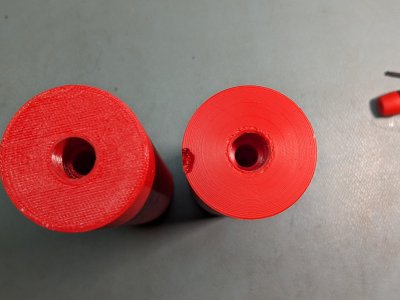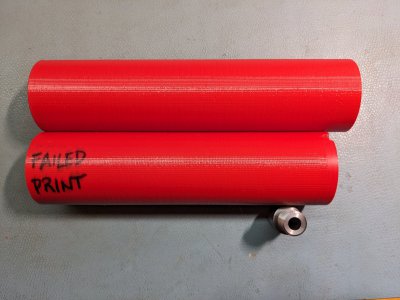I have 3 messed up parts, two of which were basket cases, so I tried again on the 3 jaw on one of the basket cases. I was able to sort of kinda get it with minimal run out. Not going to lie, I didn't measure it, but it was good enough for the experiment. I turned down the blob of PETG on the cylinder wall, and was able to face the end. There still is a large gouge, where the print head jammed into the part as it was falling over. This particular print had enough meat on the end (and 100% infill) so I tried drilling it for a 1/2-20 tap. (29/64") I was able to tap the hole and try out the design. Despite the truncated design (about 1/2" shorter) due to print failure, it worked. Not as well as the longer one, but it did function. I basically saved this basket case part. Kind of messed it up a little, but it was good enough for my test.


These are printed plastic moderator prototypes for airguns, and I am told are exempt from tax stamps and forms, since they are not to be used on firearms.
I'm doing this from an engineering perspective, trying to understand the acoustics. So I have been trying my hand at designing acoustic filters. Been trying to drag in my former microwave filter theory into the design, as there are remarkable similarities, and it's been interesting journey. Honestly, at this point, haven't found something that wows me. They are much quieter, but not "oh my goodness, that's really quiet". They do take off the edge though, and sound more like pops than reports. I'll play around with some filter concepts, just for the heck of it.
For the good print, (the longer one)
I will make a split ring and use the 4 jaw. I'll probably true up all the ends of all my parts once I get a good method going. The threads should not be the reference surface, the back of the part should be flat and parallel with the mating flange. For my system, the mating flange is the reference. The longer part, by the way, has a modified internal design and has a lower pitch. So far it is the best performer, but there's more work that can be done. Once I find what works, I need to shrink it a bit, it's a bit big for my taste. That's when it gets harder.



